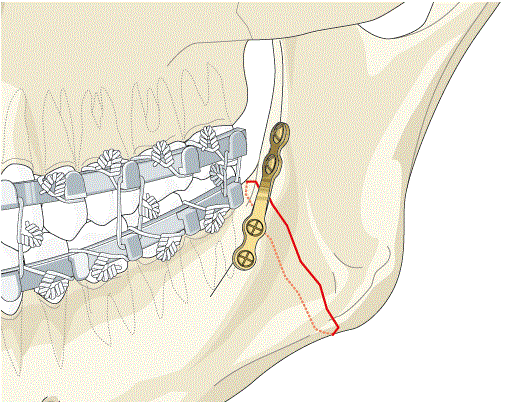Rigid fixation technique augments the process of healing by restricting any micro motions across the line of fracture. It is achieved by using orthopedic instruments like interlocking nails, locking plates etc. We are among India’s top orthopedic implant company. Founders and supporters of rigid fixation believe that this technique aims to enhance early functional activity
Rigid fixation technique augments the process of healing by restricting any micro motions across the line of fracture. It is achieved by using orthopedic instruments like interlocking nails, locking plates etc. We are among India’s top orthopedic implant company.
Founders and supporters of rigid fixation believe that this technique aims to enhance early functional activity following internal fixation of fractures and put a stop to any kind of tissue breakdown and joint stiffness.
However, the easiness of the motion of the joints and early activity is not always possible, especially after plate fixation of a certain long fractured bone. The chances of infection, delayed bone joint, and nonunion though gets significantly reduced in this method, it is not 100% eliminated. The healing of diaphyseal fractures by rigid immobilization of fragments is expected to take place without peripheral thick skin formation, and it is commonly assumed that any such callus development is a sign of failed fixation or poor healing.
The rigid plate fixation technique of repairing the fracture using the interlocking nails or locking plates defies the usual body healing procedure and changes how the fracture repairs itself. This human made procedure of healing occurs slowly and, delays the process of returning of bone to its normal state. The healing of a fracture after a rigid plate fixation is evidence of the human body’s finer capability to overcome the abnormal obstacle created by the metallic implant. Under these conditions, the fractures heal in spite of the rigid fixation.
In spite of the violations of the normal body healing process and the risks involved with the surgery, rigid internal fixation is still used in the treatment of many diaphyseal fractures. The pragmatic advantages of the surgery often overshadow the natural disadvantages. This is true in case of fracture healing. To help you understand better, here is an example. In the case of fractures between the trochanters and femoral shaft fractures which heal on its own without internal fixation, it must be treated ( in most instances) by bone fixation techniques using orthopedic implants to prevent any kind of deformity. Osteosynthesis also permits early ambulation and thus reduce the diseased condition of the patient that is caused due to prolonged lying in the rest position. The same example is also valid for many open tibial fractures, particularly those occurring from high impact injuries. Internal fixation is also the preferred choice of treatment for high-impact fractures of bones of the forearm (for Monteria and Galeazzi fractures of the ulna and radius), and for many within joint fractures where a resulting incompatibility is likely to create late degenerative osteoarthritis.
In general, most of the long bone shaft fractures caused by low impact do not require internal fixation for the maintenance of bone alignment and length. However, chances of irregularities in femoral shaft fractures of the femur are likely to occur if they are not tightly stabilized. Closed intramedullary (within the medulla) fixation of the femoral shaft has reached a high level of erudition and is often associated with low disease rate. It is considered the treatment of choice in most cases. The recent accomplishment achieved with the technique of interlocking in case of intramedullary nailing of comminuted diaphyseal fractures of the femur and open tibial fractures, is valid proof to the fact that rigid immobilization of fragments of fractured bone is not always necessary. Under weight-bearing ambulation, fragments of fractures develop copious peripheral callus, which is most likely brought about by the irritation resulting from the motion at the fracture location. There is hardly any possibility that the large callus caused is the result of the bone powder generated during the intramedullary reaming procedure.
It is not generally documented that closed fractures experience their utmost amount of shortening at the time of the initial injury. Further fracture shortening is not likely to happen postoperatively when the patient walks out of bed and performs a light activity (such as sitting, standing, or walking).
The various techniques that assure maintenance of length have been popular at dissimilar times because of a lack of admiration of the fact that additional shortening is not likely to happen with the commencement of the function or weight bearing. One technique that achieves the intended function is the external fixator technique which uses metal pins on the top and bottom area of the fracture. Nevertheless, rigid fixation of the fractured fragments eradicates the stresses which the bone must undergo in order to maintain its usual structural design. The Ilizarov system of management which uses Ilizarov apparatus for nonunion clearly illustrates the importance of motion at the fracture site. This method is successful, but not due to the rigid fixation provided by the thin wires under pressure, but because this system of management allows the motion at the fracture site. If this Ilizarov system was used in patients who were not allowed to use their extremes, the stated consequences would not have been up to the mark or quite less satisfactory. As leading orthopedic surgical instruments and Spine Implants Manufactures, we manufacture some of the finest implants. Sprain of the Cervical Spine.
In the present-day scenario, many sophisticated and high end intramedullary devices and plates with different degrees of elasticity are being studied. They work on load sharing instead of load bearing. This allows more stress in the bone and less strain on the fixation. This is being done to harness the benefits of stabilization while eliminating the negative impacts of rigid fixation. This supple intramedullary fixation supports the notion that normal motion at the fracture site enhances bone formation. For more such information, get in touch with top orthopedic implants manufacturers and orthopedic products manufacturers in India.






















Leave a Comment
Your email address will not be published. Required fields are marked with *